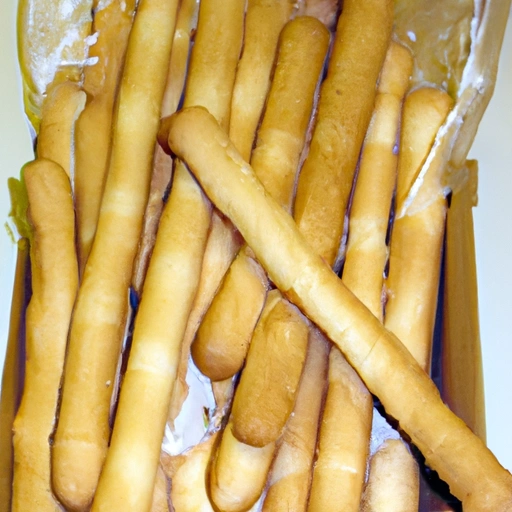Breadstick
Description

A breadstick is a pencil-shaped, crispy, dry bread originating from Italy. It's also known as 'grissino' in the Italian language. Traditionally, breadsticks are made with basic ingredients such as wheat flour, yeast, water, and salt. They may be topped with ingredients like sesame seeds, garlic, herbs, or Parmesan cheese for added flavor. Breadsticks can vary in size and thickness, ranging from thin, crunchy versions to larger, softer varieties.
Common uses
Breadsticks are commonly served as an appetizer, snack, or accompaniment to a variety of dishes. They are often found alongside antipasti, served with dips such as hummus or marinara sauce, or offered as a pre-meal nibble at restaurants. Breadsticks can also be a crunchy addition to soups and salads or used as a base for canapés.
Nutritional value
Calories
A typical serving of breadsticks, which might be one large breadstick or two to three small ones (approximately 20 grams), contains about 80-100 calories when plain.
Protein
Breadsticks generally offer around 2-3 grams of protein per serving.
Fat
The fat content in breadsticks is usually low, with about 1-2 grams per serving, unless additional ingredients like cheese or butter are added.
Carbohydrates
Carbohydrates are present in breadsticks at about 15-20 grams per serving, making them a source of quick energy.
Vitamins
Breadsticks contain minimal vitamins, but some fortified versions may include added B vitamins.
Minerals
They may also provide small amounts of minerals such as iron and calcium, especially if made with enriched flour.
Health benefits
As a low-fat, low-sugar snack, breadsticks can be a healthier alternative to other processed snacks. The carbohydrates provide energy, and when whole grains are used, breadsticks can offer dietary fiber beneficial for digestive health.
Potential risks
Due to their high sodium and simple carbohydrate content, overconsumption can lead to increased blood pressure and affect blood sugar levels. Breadsticks made from refined flour also lack significant fiber, making them less filling and potentially leading to overeating.
Common recipes
Breadsticks are featured in recipes such as breadstick pizza crusts, wrapped with prosciutto as appetizers, or crushed as a topping for casseroles for added texture.
Cooking methods
They can be baked, deep-fried, or even microwaved when reheating. Homemade versions can be customized with various mix-ins and toppings.
Pairing with other ingredients
Breadsticks pair well with cheese, wine, soups, salads, and a variety of dips. They can also complement many Italian dishes like pasta and lasagna.
Summary
Breadsticks are a popular, versatile food ingredient with a storied history and a place in various culinary traditions. They offer a mix of convenience and indulgence, useful in a wide array of recipes. Whether you're looking for a quick snack or a sophisticated appetizer, breadsticks bring texture and flavor to the table.